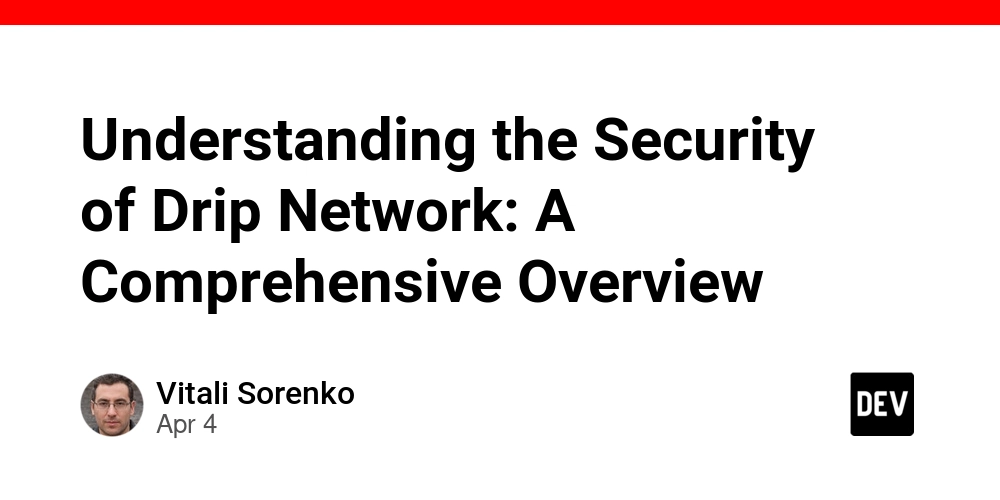Understanding the Security of Drip Network: A Comprehensive Overview
Abstract This post dives into the security framework of the Drip Network, a rising star in the DeFi ecosystem. We break down the core security features, explore its yield farming and staking protocols, and compare best practices for blockchain security. In an accessible and technical tone, the post provides background context, in-depth analysis of smart contract integrity, open‑source tokenization, and cybersecurity practices. Practical use cases, challenges, and future trends are discussed to help developers, investors, and enthusiasts better understand and evaluate the security of platforms like the Drip Network. Introduction Decentralized Finance (DeFi) continues to disrupt traditional financial systems, offering innovative ways to earn yields and access liquidity through platforms like the Drip Network. With this innovation comes the need for rock‑solid security. Understanding how the Drip Network protects user assets through advanced smart contracts and robust cybersecurity measures is critical for anyone investing in or developing on such platforms. In this post, we not only extend the discussion provided by the original article on Drip Network security but also add broader insights about open source tokenization, blockchain cybersecurity, and risk management in DeFi. Our discussion covers: The historical context and emergence of DeFi platforms. Key security concepts and features inherent to the Drip Network. Real-world applications and use cases including yield farming and staking. Challenges and limitations faced by the platform in a rapidly evolving landscape. Future outlook and anticipated innovations in blockchain security. By the end of this article, you will gain holistic insight into how the Drip Network stands out in terms of security and why its methods can serve as strong benchmarks for other platforms. Background and Context The evolution of Decentralized Finance has been nothing short of groundbreaking. At its core, DeFi leverages blockchain technology to bypass traditional financial intermediaries, allowing for direct peer-to-peer transactions and trustless interactions. Platforms like the Drip Network offer innovative yield farming and staking options—empowering users to optimize returns on their digital assets. Historically, the surge in DeFi platforms has been paralleled by growing concerns over cybersecurity. To mitigate risks, developers started integrating smart contracts on blockchain with complex security protocols. These contracts, by design, operate on self‑executing code that is transparent and immutable. The Drip Network takes advantage of these principles, coupling them with open‑source contributions to ensure not only functionality but also public auditability and enhanced trust. Key terms and definitions include: Smart Contracts: Self‑executing contracts with the rules of the agreement directly written into code. Yield Farming: Strategies that allow users to earn rewards by contributing their assets to liquidity pools. Staking Protocols: Mechanisms that enable users to lock up tokens in return for potential rewards and network validation. Open source sustainability, as discussed on pages like sustainability of open source through tokenization, plays a vital role in ensuring that security practices remain updated and are continuously reviewed by a global community of developers. Core Concepts and Features When detailing the security practices of the Drip Network, several core concepts deserve attention: 1. Smart Contract Integrity The Drip Network relies on robust smart contracts built on blockchain technology. These are designed and deployed with several layers of security checks to prevent exploits and vulnerabilities common in decentralized systems. The smart contracts on blockchain serve as a self‐auditing mechanism, ensuring transactions are tamper‑proof and transparent. 2. Yield Farming and Staking Security Yield farming on the Drip Network involves staking tokens to earn rewards. This process is underpinned by secure staking protocols that reward long‑term commitment while minimizing risks such as liquidity attacks. For a deeper look into staking security, refer to the detailed exploration on drip network staking. 3. Open Source Development and Audits Being an open source project means that the code behind the Drip Network is available for public scrutiny. This openness not only accelerates innovation but also allows independent audits that can detect and correct vulnerabilities. This model is similar to other open source initiatives and has been discussed in resources like sustainability of open source through tokenization. 4. Cybersecurity and Blockchain Utilizing the inherent security features of blockchain, the Drip Network benefits from decentralized data storage, immutability, and robust consensus mechanisms that protect against common cyber th

Abstract
This post dives into the security framework of the Drip Network, a rising star in the DeFi ecosystem. We break down the core security features, explore its yield farming and staking protocols, and compare best practices for blockchain security. In an accessible and technical tone, the post provides background context, in-depth analysis of smart contract integrity, open‑source tokenization, and cybersecurity practices. Practical use cases, challenges, and future trends are discussed to help developers, investors, and enthusiasts better understand and evaluate the security of platforms like the Drip Network.
Introduction
Decentralized Finance (DeFi) continues to disrupt traditional financial systems, offering innovative ways to earn yields and access liquidity through platforms like the Drip Network. With this innovation comes the need for rock‑solid security. Understanding how the Drip Network protects user assets through advanced smart contracts and robust cybersecurity measures is critical for anyone investing in or developing on such platforms. In this post, we not only extend the discussion provided by the original article on Drip Network security but also add broader insights about open source tokenization, blockchain cybersecurity, and risk management in DeFi.
Our discussion covers:
- The historical context and emergence of DeFi platforms.
- Key security concepts and features inherent to the Drip Network.
- Real-world applications and use cases including yield farming and staking.
- Challenges and limitations faced by the platform in a rapidly evolving landscape.
- Future outlook and anticipated innovations in blockchain security.
By the end of this article, you will gain holistic insight into how the Drip Network stands out in terms of security and why its methods can serve as strong benchmarks for other platforms.
Background and Context
The evolution of Decentralized Finance has been nothing short of groundbreaking. At its core, DeFi leverages blockchain technology to bypass traditional financial intermediaries, allowing for direct peer-to-peer transactions and trustless interactions. Platforms like the Drip Network offer innovative yield farming and staking options—empowering users to optimize returns on their digital assets.
Historically, the surge in DeFi platforms has been paralleled by growing concerns over cybersecurity. To mitigate risks, developers started integrating smart contracts on blockchain with complex security protocols. These contracts, by design, operate on self‑executing code that is transparent and immutable. The Drip Network takes advantage of these principles, coupling them with open‑source contributions to ensure not only functionality but also public auditability and enhanced trust.
Key terms and definitions include:
- Smart Contracts: Self‑executing contracts with the rules of the agreement directly written into code.
- Yield Farming: Strategies that allow users to earn rewards by contributing their assets to liquidity pools.
- Staking Protocols: Mechanisms that enable users to lock up tokens in return for potential rewards and network validation.
Open source sustainability, as discussed on pages like sustainability of open source through tokenization, plays a vital role in ensuring that security practices remain updated and are continuously reviewed by a global community of developers.
Core Concepts and Features
When detailing the security practices of the Drip Network, several core concepts deserve attention:
1. Smart Contract Integrity
The Drip Network relies on robust smart contracts built on blockchain technology. These are designed and deployed with several layers of security checks to prevent exploits and vulnerabilities common in decentralized systems. The smart contracts on blockchain serve as a self‐auditing mechanism, ensuring transactions are tamper‑proof and transparent.
2. Yield Farming and Staking Security
Yield farming on the Drip Network involves staking tokens to earn rewards. This process is underpinned by secure staking protocols that reward long‑term commitment while minimizing risks such as liquidity attacks. For a deeper look into staking security, refer to the detailed exploration on drip network staking.
3. Open Source Development and Audits
Being an open source project means that the code behind the Drip Network is available for public scrutiny. This openness not only accelerates innovation but also allows independent audits that can detect and correct vulnerabilities. This model is similar to other open source initiatives and has been discussed in resources like sustainability of open source through tokenization.
4. Cybersecurity and Blockchain
Utilizing the inherent security features of blockchain, the Drip Network benefits from decentralized data storage, immutability, and robust consensus mechanisms that protect against common cyber threats. For more detailed insights into blockchain-enhanced cybersecurity, check out blockchain and cybersecurity.
5. Legitimacy and Community Trust
An essential aspect of the overall security model is the platform’s legitimacy. Transparent operations and continuous community engagement foster trust. More details on proven legitimacy can be found in the discussion on drip network legitimacy.
Below is a bullet list summarizing the key security features:
- Robust Smart Contracts: Immutable and publicly audited code.
- Layered Staking Protocols: Secure mechanisms to minimize risk.
- Community-Driven Audits: Open source model for continuous improvement.
- Decentralized Cybersecurity: Utilization of blockchain’s inherent security properties.
- Legitimacy Through Transparency: Active community governance and clear operational protocols.
Applications and Use Cases
The security features of the Drip Network translate into practical applications that benefit both everyday users and sophisticated investors.
Use Case 1: Yield Farming Optimization
Users can deploy their digital assets within the Drip Network to earn a consistent yield over time. The network’s secure staking protocols ensure that funds are protected during the yield farming process. By using robust smart contracts, users minimize the risk of hacking and ensure that rewards are accurately and automatically distributed. This model mirrors the practices celebrated in projects discussed in understanding the Drip Network market cap.
Use Case 2: Secure Staking for Long-Term Holders
Staking on the Drip Network not only provides rewards but also reinforces network integrity. Long-term stakers benefit from security measures that deter malicious activities. This trust in staking security is a cornerstone of the network’s value proposition in protecting sizable investments while generating passive income. More technical details on these staking protocols are available on drip network staking.
Use Case 3: Cross-Platform Integration and Use Cases
Developers and investors are exploring the further utility of the network by integrating it with other DeFi platforms. Its robust security measures make it an attractive option for cross-chain applications and collaborations. For example, interoperability and referral systems add layers of functionality while ensuring transparency and security. See more about practical applications on drip network use cases.
Comparison of DeFi Security Approaches
To further understand how the Drip Network stands apart, consider the following table that compares security aspects across common DeFi platforms:
| Feature | Drip Network | Other DeFi Platforms |
|---|---|---|
| Smart Contract Audits | Regular, community-driven audits | Varies; some projects lack continuous audits |
| Staking Security | Robust protocols with multiple safeguards | Many underdeveloped staking systems |
| Transparency | Fully open source and transparent operations | Some elements hidden from public view |
| Cybersecurity Model | Leverages blockchain’s immutability, decentralized consensus | Varies; traditional centralization risks |
| Community Trust | High due to active engagement and open code | Often challenged by past vulnerability issues |
The table above highlights why many users value the Drip Network; its features emphasize not only advanced technology but also sustainable community engagement for ongoing security improvements.
Challenges and Limitations
Despite a promising framework, the Drip Network, like all DeFi projects, faces challenges:
1. Technical Vulnerabilities in Complex Contracts
While smart contracts are designed to be secure, complexity can sometimes lead to unforeseen loopholes. Ensuring that code remains bug‑free is an ongoing challenge, even with the benefits of open source auditing. Unplanned vulnerabilities can be exploited, highlighting the need for continuous code reviews and improvements.
2. Scalability Concerns
As user adoption grows, platforms like the Drip Network must manage increased traffic without compromising security or performance. Scalability challenges—such as network congestion—can directly impact transactional speed and overall security. Solutions may involve Layer‑2 scaling or further decentralization.
3. Regulatory and Compliance Issues
The decentralized nature of DeFi platforms poses regulatory challenges. Although decentralization can offer security benefits, it can also lead to uncertainty in legal frameworks, making compliance an opaque matter. This regulatory grey area sometimes reduces investor confidence.
4. User Experience vs. Security Trade-offs
To keep systems secure, developers sometimes implement mechanisms that can add complexity for the end user. Balancing robust security with a seamless user experience is an ongoing challenge. Enhancing transparency without sacrificing ease of use is a delicate balance that requires constant innovation.
5. Market Volatility and External Threats
The DeFi space is subject to market volatility as well as concerted attacks by sophisticated hackers. While the security mechanisms in place are designed to manage risk, external factors such as sudden market shocks can expose vulnerabilities that require rapid responses and protocol adjustments.
Future Outlook and Innovations
Looking ahead, several trends are expected to shape the future of security in the DeFi landscape and, by extension, the Drip Network:
Enhanced Auditing Technologies
Automation and advanced analytical tools will likely improve the frequency and accuracy of smart contract audits. With machine learning algorithms and improved static analysis tools, vulnerabilities could be detected and remedied more efficiently.
Cross‑Chain Security Solutions
Interoperability between various blockchain networks will necessitate novel cross-chain security models. Future enhancements could see the Drip Network collaborating with other protocols to enhance security through interoperability layers, reducing risks associated with isolated ecosystems.
Advanced Consensus Mechanisms
Emerging consensus mechanisms, including proof‑of‑stake upgrades and novel vote‑based systems, may significantly influence the security and scalability of decentralized platforms. These innovations promise to decentralize validation further, making operating networks much more resilient against coordinated cyberattacks.
Integrated Compliance Frameworks
As regulators become more engaged with DeFi, future iterations of security protocols might incorporate built‑in compliance features. These could automate elements of legal adherence, minimizing risks of regulatory intervention and making the platforms more attractive to institutional investors.
Community‑Driven Enhancements
The open source model fosters a community of passionate developers who continuously refine code and propose innovative security features. As more developers contribute, both the codebase and its reputation for reliability will improve, driving further adoption and trust.
For additional perspectives on open source innovations and security, check out these insightful posts on Dev.to:
- Understanding the Drip Network Market Cap – A Comprehensive Analysis Explained
- Navigating Open Source Funding for Startups: Opportunities and Challenges
- Navigating the Financial Sustainability of Open Source Projects
These articles not only provide complementary perspectives on economic sustainability but also highlight the intertwined nature of financial security and technical robustness in modern blockchain projects.
Summary
In this comprehensive overview, we dissected the security architecture of the Drip Network—a key component in today’s DeFi ecosystem. Our discussion began with a background into the evolution of decentralized systems and continued by detailing the core concepts that underpin Drip Network’s security:
- Smart Contract Integrity ensures that every transaction is recorded immutably on the blockchain.
- Staking Protocols provide a secure way to earn rewards while protecting user investments.
- Open Source Audits and Community Trust bolster the platform’s reliability and continuous improvement, essential for handling emerging threats.
- Cybersecurity Best Practices drawn from blockchain technology fortify the network against external attacks.
We reviewed practical applications such as yield farming optimization, secure staking for long-term users, and ways to foster cross‑chain integrations. At the same time, the post addressed challenges ranging from technical vulnerabilities to regulatory uncertainties. Looking to the future, advancements like automated auditing, enhanced cross‑chain security, and integrated compliance frameworks promise to further solidify the network’s defenses.
For those keen on exploring the technical nuances further, here are additional resources for deeper insights:
- Drip Network Official Site
- DeFi Security on Medium
- Smart Contracts on Blockchain
- Sustainability of Open Source Through Tokenization
- Blockchain and Cybersecurity
Additionally, consider exploring these focused articles from our partner links:
In sum, understanding the security architecture of the Drip Network is essential in a world where DeFi adoption grows rapidly. The network’s commitment to transparent, community‑driven, and cutting‑edge security practices sets an important precedent in decentralized finance. This level of security not only protects user assets but also builds the trust required for the broader adoption of blockchain technologies.
Through continuous improvements in smart contract auditing, proactive cybersecurity measures, and supportive regulatory frameworks, platforms like the Drip Network are poised to lead the next phase of innovation in digital finance.
Secure, innovative, and community‑oriented – the future of DeFi and blockchain security is bright.
Happy exploring, and stay secure in your DeFi journey!










































































































































































![[The AI Show Episode 142]: ChatGPT’s New Image Generator, Studio Ghibli Craze and Backlash, Gemini 2.5, OpenAI Academy, 4o Updates, Vibe Marketing & xAI Acquires X](https://www.marketingaiinstitute.com/hubfs/ep%20142%20cover.png)



























































































































![[FREE EBOOKS] The Kubernetes Bible, The Ultimate Linux Shell Scripting Guide & Four More Best Selling Titles](https://www.javacodegeeks.com/wp-content/uploads/2012/12/jcg-logo.jpg)



![From drop-out to software architect with Jason Lengstorf [Podcast #167]](https://cdn.hashnode.com/res/hashnode/image/upload/v1743796461357/f3d19cd7-e6f5-4d7c-8bfc-eb974bc8da68.png?#)






































































































.png?#)




.jpg?#)
































_Christophe_Coat_Alamy.jpg?#)







































































































![Rapidus in Talks With Apple as It Accelerates Toward 2nm Chip Production [Report]](https://www.iclarified.com/images/news/96937/96937/96937-640.jpg)









































































































































